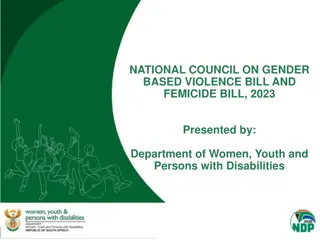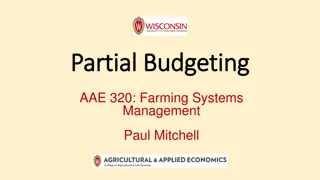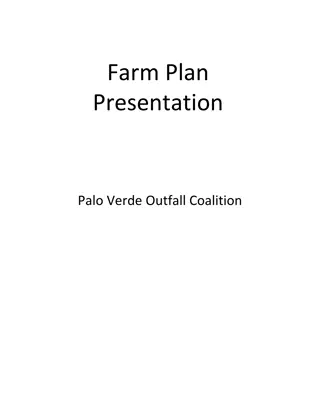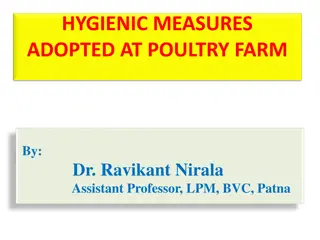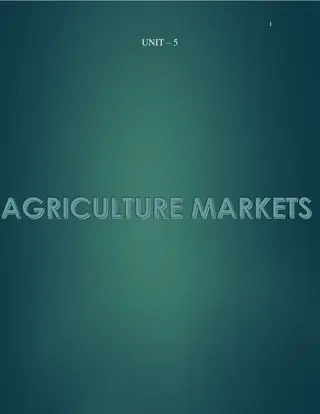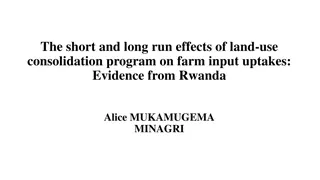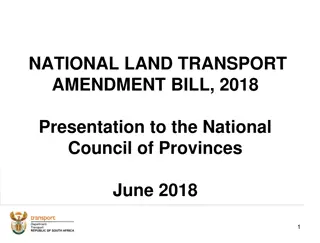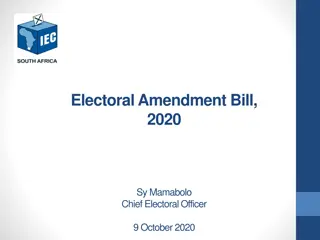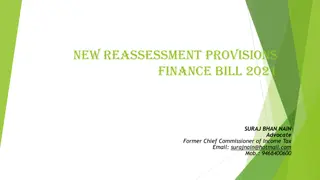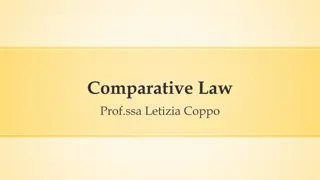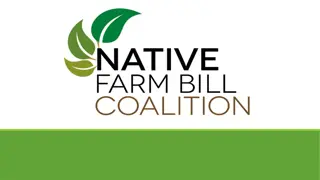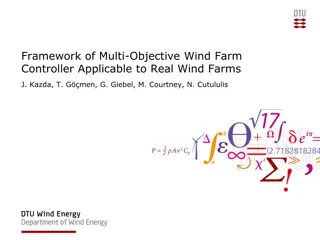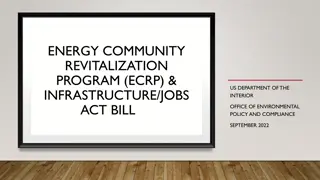Overview of 2014 Federal Farm Bill Provisions
The 2014 Federal Farm Bill introduced various amendments impacting conservation compliance, pollinator protection, the Conservation Reserve Program (CRP), and easement programs. Changes included recoupling federal crop insurance benefits to conservation requirements, extending pollinator protection provisions, reducing CRP acreage, and repealing easement programs. Additionally, the Agricultural Conservation Easement Program (ACEP) aimed to combine functions of previous programs to restore wetlands and protect agricultural land. Funding for ACEP varied over fiscal years, emphasizing regulatory development for future implementation.
Uploaded on Sep 06, 2024 | 2 Views
Download Presentation

Please find below an Image/Link to download the presentation.
The content on the website is provided AS IS for your information and personal use only. It may not be sold, licensed, or shared on other websites without obtaining consent from the author.If you encounter any issues during the download, it is possible that the publisher has removed the file from their server.
You are allowed to download the files provided on this website for personal or commercial use, subject to the condition that they are used lawfully. All files are the property of their respective owners.
The content on the website is provided AS IS for your information and personal use only. It may not be sold, licensed, or shared on other websites without obtaining consent from the author.
E N D
Presentation Transcript
3/14/14 2014 Federal Farm Bill Overview
Conservation Compliance Recoupling federal crop insurance premium support benefits to HEL and wetland conservation compliance requirements (Sod Buster and Swamp Buster) Mandated USDA-assisted wetland mitigation banking program New provisions apply solely to crop insurance only participants 2
Pollinators Pollinator protection provisions enacted in 2008 extended to 2018 USDA to publish guidance on enhancing long term pollinator health and long term viability of pollinators. Requirement to provide recommendations to Congress regarding how to better coordinate Federal agency efforts to address the decline of managed honey bees and native pollinators. . 3
Conservation Reserve Program CRP reauthorized but reduced from 32 million acres to 24 million acres over the next 5 years Creates a two million acre reserve for grassland acres targeting expiring CRP. Cropping history not required. 4
Easement Programs Farm & Ranch Land Protection Program (FRPP), Grassland Reserve Program (GRP), and Wetlands Reserve Program (WRP) have been repealed 5
Easements Agricultural Conservation Agricultural Conservation Easement Program Easement Program FRPP GRP WRP 6
ACEP 7
ACEP The purposes of ACEP include: Combine the purposes and coordinate the functions of the WRP, GRP, and FRPP. Restore, protect, and enhance wetland on eligible land. Protect the agricultural use, viability, and related conservation values of eligible land by limiting non- agricultural uses. Protect grazing uses and related conservation values by restoring and conserving eligible land. 8
ACEP ACEP funded at $400 million in fiscal year 2014, increasing to $500 million in fiscal year 2017, and reducing to $250 million in fiscal year 2018. During FY 2014 USDA plans to develop and publish ACEP regulations to administer ACEP in FY 2015 and subsequent fiscal years. 9
ACEP ACEP Wetland Reserve Easement (WRE) Reduces ownership requirement from 7 years to 24 months Authorizes waiver process to allow enrollment of CRP land established to trees. No option to enroll stand-alone restoration cost- share agreements. (Not previously used in MN) 10
Agricultural Land Easements (ALE) The 2014 Farm Bill rescinds authority to enter into new agreements or contracts for GRP The purposes of GRP are now contained within the Agricultural Conservation Easement Program Agricultural Lands Easement New requirement of 50% match opportunity for MN to get grassland acres! 11
Wetland Reserve Easements (WRE) NRCS will continue to compensation Priority for enrollment continues to be based on value of the easement for protecting and enhancing habitat for migratory birds and other wildlife 12
Wetland Reserve Easements (WRE) Enrollment Options Permanent 30-year Easement 30 year contract to Indian Tribes 13
Wetland Reserve Easements (WRE) The enactment of the 2014 Act requires that new enrollments are made using ACEP-WRE authorities. Transition guidance to address funding for prior year enrollment activities as well as new FY 2014 enrollments is forthcoming. 14
Regional Conservation Partnership Regional Conservation Partnership Program (RCPP) Program (RCPP) 15
RCPP RCPP RCPP is a new regional program that: Furthers the conservation, restoration, and sustainable use of soil, water, wildlife on a regional scale Encourages partners to cooperate with producers Provides assistance through: Partnership agreements Program contracts or easement agreements Combines and replaces the purposes and functions of previous partnerships such as MRBI 16
RCPP RCPP Covered programs: Agricultural Conservation Easement Program (ACEP) Environmental Quality Incentives Program (EQIP) Conservation Stewardship Program (CStP) Healthy Forests Reserve Program (HFRP) 17
RCPP Funding RCPP Funding Available Funding $100 Million of Direct RCPP funding each year 7% of funds from the four covered programs (ACEP, CStP, EQIP, HFRP) reserved annually through April 1st 18
RCPP Funding RCPP Funding Funding Allocation 25% for State Projects 40% for National Projects 35% for Projects in Critical Conservation Areas 19
RCPP RCPP Critical Conservation Areas Secretary will select up to 8 critical conservation areas Priority consideration given to geographical areas which: Include multiple States with significant ag production Have an existing agreement or work plans Benefit water quality and quantity improvement Assist producers to meet natural resource regulatory requirements 20
RCPP RCPP Partnership Agreements: NRCS will conduct a competitive process to select applications for partnership agreements NRCS will make public the criteria used in evaluating 21
RCPP Partners are responsible for: Contributing a significant portion of the overall costs Conducting outreach and education Leveraging financial or technical assistance provided by NRCS with additional funds to help achieve the project objectives. Conducting and providing an assessment of the project costs and conservation effects No funding may be used to cover partner administrative costs 22
RCPP RCPP will be implemented this year. Additional guidance on fund distribution and program management will be provided. 23
Questions? 25


